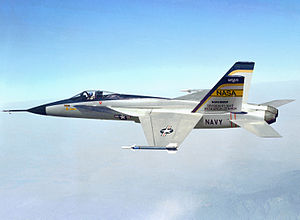The first prototype (serial number 72-1569) was rolled out at Hawthorne on 4 April 1974; its first flight at Edwards AFB came on 9 June with Henry “Hank” Chouteau at the controls [4] flying for 61 minutes reaching an altitude of 18,000 feet and a maximum speed of 610 miles per hour.[5]  Chouteau afterward remarked that “When our designers said that in the YF-17 they were going to give the airplane back to the pilot, they meant it. It’s a fighter pilot’s fighter.”[5]
Chouteau afterward remarked that “When our designers said that in the YF-17 they were going to give the airplane back to the pilot, they meant it. It’s a fighter pilot’s fighter.”[5]
The Northrop YF-17 (nicknamed “Cobra”) was a prototype lightweight fighter aircraft designed by Northrop aviation for the United States Air Force’s Lightweight Fighter (LWF) technology evaluation program. The LWF was initiated because many in the fighter community believed that aircraft like the F-15 Eagle were too large and expensive for many combat roles. The YF-17 was the culmination of a long line of Northrop designs, beginning with the N-102 Fang in 1956, continuing through the F-5 family.
Although it lost the LWF competition to the F-16 Fighting Falcon, the YF-17 was selected for the new Naval Fighter Attack Experimental (VFAX) program. In enlarged form, the F/A-18 Hornet was adopted by the United States Navy and the United States Marine Corps to replace the A-7 Corsair II and F-4 Phantom II, complementing the more expensive F-14 Tomcat.[1] This design, conceived as a small and lightweight fighter, was scaled up to the Boeing F/A-18E/F Super Hornet, which is similar in size to the original F-15.
Source:Wikipedia
